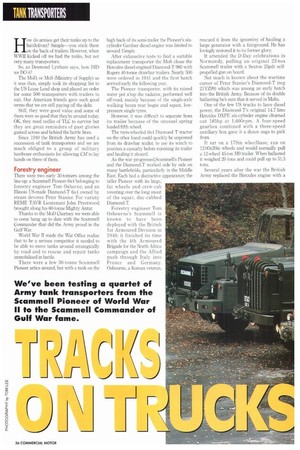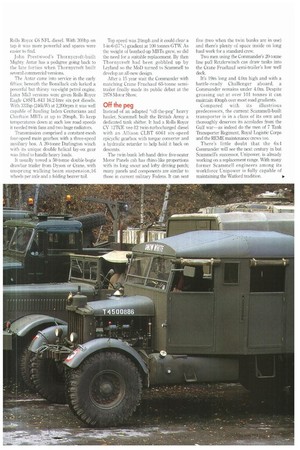H ow do armies get their tanks up to the battlefront?
Page 38

Page 39

If you've noticed an error in this article please click here to report it so we can fix it.
Simple—you stick them on the back of trailers However, when WWII kicked off we had the tanks, but not very many transporters.
So, as Desmond Lynham says, how DID we DO it?
The MoD, or MoS (Ministry of Supply) as it was then, simply took its shopping list to the US Lease Lend shop and placed an order for some 500 transporters with trailers to suit. Our American friends gave such good terms that we are still paying off the debt.
Still, they were good value and some of them were so good that they're around today OK, they need oodles of TLC to survive but they are great reminders of past glories gained across and behind the battle lines.
Since 1940 the British Army has used a succession of tank transporters and we are much obliged to a group of military hardware enthusiasts for allowing CM to lay hands on three of them.
Forestry engineer
There were two early 30-tonners among the line-up: a Scammell Pioneer 6x4 belonging to forestry engineer Tom Osborne; and an Illinois US-made Diamond-T 6x4 owned by steam devotee Peter Stainer. For variety REME T.AIIR Lieutenant John Prestwood brought along his 60-tonne Mighty Antar.
Thanks to the MoD Chertsey we were able to come bang up to date with the Scammell Commander that did the Army proud in the Gulf War.
World War II made the War Office realise that to be a serious competitor it needed to be able to move tanks around strategically by road and to rescue and repair tanks immobilised in battle.
There were a few 30-tonne Scammell Pioneer artics around, but with a tank on the high back of its semi-trailer the Pioneer's sixcylinder Gardner diesel engine was limited to around 15mph.
After exhaustive tests to find a suitable replacement transporter the MoS chose the Hercules diesel-engined Diamond-T 980 with Rogers 40-tonne drawbar trailers. Nearly 500 were ordered in 1941 and the first batch arrived early the following year.
The Pioneer transporter, with its raised water pot atop the radiator, performed well off-road, mainly because of the single-axle walking beam rear bogie and squat, lowpressure single tyres.
However, it was difficult to separate from its trailer because of the unusual spring loaded fifth wheel.
The twin.wheelecl 6x4 Diamond T tractor on the. other hand could quickly be unpinned from its drawbar trailer, to use its winch to position a casualty before rejoining its trailer and hauling it aboard.
As the war progressed,Scammell's Pioneer and the Diamond-T worked side by side on many battlefields, particularly in the Middle East. Each had a distinctive appearance; the taller Pioneer with its large. fat wheels and crew-cab towering over the long snout of the squat, day-cabbed Diamond-T.
Forestry engineer Tom Osbourne's Scammell is known to have been deployed with the British 1st Armoured Division in 1940; it finished its time with the 4th Armoured Brigade for the North Africa campaign and the Allied push through Italy into France and Germany. Osbourne, a Korean veteran, rescued it from the ignominy of hauling a large generator with a fairground. He has lovingly restored it to its former glory.
It attended the D-Day celebrations in Normandy, pulling an original 22-ton Scammell trailer with a Sexton 25pdr selfpropelled gun on board.
Not much is known about the wartime career of Peter Stanier's Diamond-T (reg 21YZ99) which was among an early batch into the British Army Because of its double ballasting he's sure that it served in Malta.
One of the few US trucks to have diesel power, the Diamond-T's original 14.7-litre Hercules DXEE six-cylinder engine churned out 185hp at 1,600rpm. A four-speed gearbox combined with a three-speed auxiliary box gave it a dozen cogs to pick from.
It sat on a 179in wheelbase, ran on 12.00x2Oin wheels and would normally pull a 12-wheel 45-ton M9 trailer. When ballasted it weighed 20 tons and could pull up to 51.3 tons.
Several years after the war the British Army replaced the Hercules engine with a Rolls Royce C6 NFL diesel. With 300hp on tap it was more powerful and spares were easier to find.
John Prestwood's Thornycroft-built Mighty Antar has a pedigree going back to the late forties when "Ishornyeroft built several commercial versions.
The Antar came into service in the early fifties: beneath the Banallack cab lurked a powerful but thirsty vcc-eight petrol engine. Later Mk3 versions were given Rolls Royce Eagle C8SFL-843 16.2-litre six-pot diesels. With :133hp (246kW) at 2,200rpm it was well capable of hauling laden Centurians and Chieftain MBTs at up to 20mph. To keep temperatures down at such low road speeds it needed twin fans and two huge radiators.
Transmission comprised a constant-mesh four-speed main gearbox with a three-speed auxiliary box. A 20-tonne Darlington winch with its unique double helical lay-on gear was fated to handle heavy loads.
It usually towed a 50-tonne double-bogie drawbar trailer from Dyson or Crane, with unsprung walking beam suspension 16 wheels per axle and a folding beaver Top speed was 24mph and it could clear a 1-in-6 (17°0) gradient at 100 tonnes GTW As the weight of bombed-up MBTs grew, so did the need for a suitable replacement. By then "Ishornycroft had been gobbled up by Leyland so the MoD turned to Scammell to develop an all-new design.
After a 15 year wait the Commander with matching Crane Fruehauf 65-torme semitrailer finally made its public debut at the 1978 Motor Show.
Off the peg
Instead of an adapted "off-the-peg" heavy hauler, Scammell built the British Army a dedicated tank shifter. It had a Rolls Royce CV 12TCE vee-12 twin-turbocharged diesel with an Allison CLBT 6061 six-speed epicyclic gearbox with torque converter and a hydraulic retarder to help hold it back on descents.
The twin-bunk left-hand drive five-seater Motor Panels cab has rhino-like proportions with its long snout and lofty driving perch; many panels and components are similar to those in current military Fodens. It can seat five (two when the twin bunks are in use and there's plenty of space inside on long haul work for a standard crew.
Two men using the Commander's 20-tonne line pull Retzlerwinch can draw tanks into the Crane Fruehauf semi-trailer's low well deck.
It's 19m long and 4.0m high and with a battle-ready Challenger aboard, a Commander remains under 4.0m. Despite grossing out at over 101 tonnes it can maintain 40mph over most road gradients.
Compared with its illustrious predecessors, the current Scammell-built transporter is in a class of its own and thoroughly deserves its accolades from the Gulf war—as indeed do the men of 7 Tank Transporter Regiment, Royal Logistic Corps and the REME maintenance crews too.
There's little doubt that the 6x4 Commander will see the next century in but Scammell's successor, Unipower, is already working on a replacement range. With many former Scammell engineers among its workforce Unipower is fully capable of maintaining the Watford tradition.




















































































































